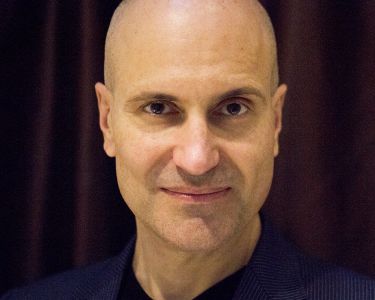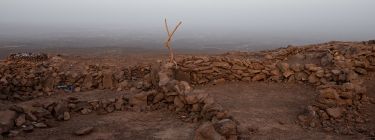
A Culture of Ecology: the 21st Century Renaissance
Fellow at King’s College London
and The National Gallery X, London
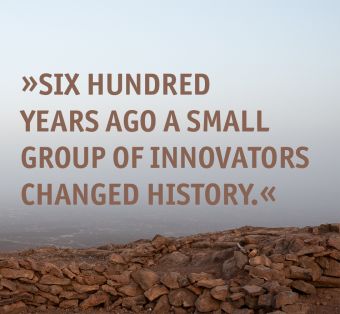
A Culture of Ecology: the 21st Century Renaissance
Beauty, epiphany, neurons
Six hundred years ago a small group of innovators changed history. They lived in Italy, and the name of their era, the Renaissance, is delightfully compact. It means rebirth, renewal and the emergence of new character. Europe has experienced more than one renaissance, but the Quattrocento occupies a special place in the imagination. The reason is clear. Unlike comparable eras, the Italian Renaissance produced colourful characters who embody wide-ranging achievement: Renaissance people who excelled in the arts, science and engineering. The influence of Filippo Brunelleschi, Leon Battista Alberti and Leonardo da Vinci spread throughout Europe, and they continue to inspire the world. In most eras we discourage polymaths, but we make an exception for Quattrocento genius.
Header photo: View from Erte Ale volcano in Ethiopia
This was a study for the performance installation ›Epiphany: The Cycle of Life.‹ (c) 2015 Ali Hossaini
Photo below: Epiphany: The Cycle of Life
Singer Netsayi and the Young People’s Chorus of New York City perform ›Epiphany: The Cycle of Life‹ at BAM in New York City. (c) 2015 Ali Hossaini
What lessons can we take from the Italian Renaissance? Contemporary society demands specialisation for good reason. Centuries of research, documentation and industrialisation have created deep wells of knowledge. Sub-disciplines of art, science, engineering take long years to master, and they possess cultures that minimise outside influence. Specialisation has brought spectacular results, but perhaps it has limits. One of the Quattrocento’s best-known products, drawing in perspective, offers a case study in the benefits of multidisciplinary training.
Perspective uses optical codes to create realistic images. Painting dominates discussions of it, but the technique’s application goes beyond art. Perspective is a science in its own right, and the ability to represent objects with mathematical accuracy supported a spectrum of progress in Europe. Engineers adapted perspective to develop machines. Anatomy, botany, astronomy and other sciences benefited from accurate drawings. Cartographers created navigational maps, and maritime nations used improved technology to pursue interests at home and abroad. The Renaissance boost to Europe upset the world’s balance of power.
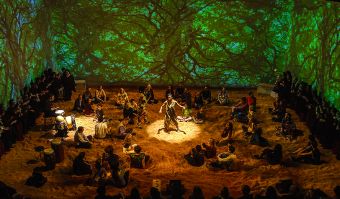
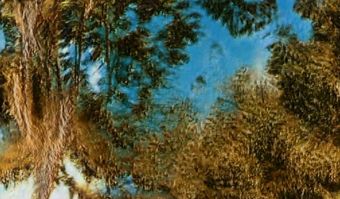
It was not a given that 15th-century Italy would invent perspectival drawing. Euclid codified optics over two thousand years ago, and some scholars argue that the ancient Greeks applied perspective to painting, architecture and theatre. As the name implies, the Renaissance was a rebirth of classical learning. But the Italians of the Quattrocento went further than the ancients, and perspective spread across Europe from Italy, and from Europe to the world. We can describe perspective in one stroke. By applying science to art, and shaping science with art, Renaissance polymaths created the flat panel display.
The beauty of perspectival art reveals the structure of space. Our first guide to perspective is Alberti’s 1435 treatise On Painting, a slender volume which generated incalculable economic value when its techniques were applied to new disciplines. Within a century of Alberti’s treatise, inventors used the camera obscura to automate perspectival drawing, and, within decades, Louis Daguerre and William Henry Fox Talbot industrialised it by inventing photography: drawing with light. To this day, cameras are a locus of innovation, notably in mobile handsets, that charge economic growth. At the same time, the camera is a useful metaphor in digital media. Gaming and animation developers use a ‚camera tool‘ to define the user’s point of view. Today’s 3D design software is one of Alberti’s many heirs.
Here is a curious fact. We perceive the world in three dimensions, and people desire rich immersive experiences. Huge investments have been made in next-generation spatial media platforms since the 1950s. Yet 3D cinema, VR and other forms of immersive media have not replaced flat panel perspective. Investors have waited more than half a century for the transition to spatial media. Why do 600-hundred-year-old techniques—the linear perspective of Brunelleschi, Alberti and da Vinci—continue to dominate creative production?
The stakes are high. When aggregated into XR (Extended Reality), spatial media could transform the Internet into a ‚multiverse‘, a pervasive data environment that merges with the physical world. Nations, corporations and individuals are vying to create the first-generation multiverse, and whoever founds it stands to gain enormous capital through first-mover advantage.

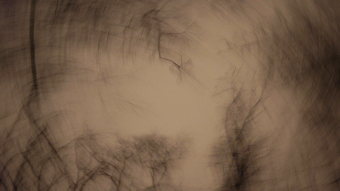
We can speculate on why a spatial multiverse eludes us. Is it because polymaths invented the flat panel display? Renaissance engineers were accomplished artists and scientists; indeed, it is impossible to characterise them with a single word. Their aesthetics embodied intellectual and technical rigour, and they combined innovation with humane values. Consider Brunelleschi’s architectural masterpiece, Il Duomo. Accidents commonly mar construction, but, during Brunelleschi’s management, Florence’s cathedral was erected without a death. Renaissance polymaths studied ancient texts, but they probed nature with tools of their own invention. They envisioned modern science by creating humane environments filled with beautiful objects.
Contrast the Quattrocento with today. Contemporary professionals specialise while the paragons of the Italian Renaissance embodied wide-ranging talent. Perhaps this explains their lasting influence. Drawing in perspective was not instantly popular. Now we take the medium for granted, but 15th-century audiences treated perspective as advanced technology: difficult to learn, marginalised and controversial. Perspective’s utility did not immediately show, and its power to create illusions seemed a gift from Satan. But Renaissance paintings incorporate fine aesthetics. Their masters created paradigms for the media they invented.
Perspective could have been popularised earlier. By the Middle Ages, the science of perspectiva, or optics, was well-established in European universities. After the classical era, Islamic scientists such as Ibn al-Haytham refined it, and mediaeval European painters such as Giotto experimented with spatial illusion. Finally, in the late 14th century, Claudius Ptolemy’s Geography surfaced in Florence’s educated circles. In Geography, Ptolemy describes how to portray the Earth’s sphere on a flat surface, and it is likely that this technique inspired Renaissance experiments. What did Brunelleschi and his colleagues add to the established science of optics? An aesthetic tradition and the desire to draw with scientific accuracy.
Let me speak as an artist. What’s missing from spatial media is a coherent world view. Unlike Renaissance paintings, recent generations of spatial media dropped into a creative and ethical vacuum. Renaissance inventors drew on the ascendence of humane values, and their work embodied visual harmonies that were ethical as well as aesthetic. They were creatures of their time who championed ascendent humanism.
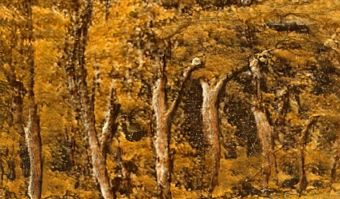
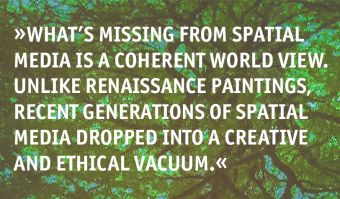
Let me ask again: What lessons can we take from the Renaissance? Aesthetics and contemporary ethics should drive engineering. Technology should express its time; it should express the possibilities and necessities of the moment. Consider another great polymath. In the early 19th century, the Prussian explorer Alexander von Humboldt travelled the world in a quest for grounding principles. Arguably the founder of ecology, von Humboldt published illustrated books that demonstrated interconnections among the physical world, the biological environment and human interventions. Though celebrated while alive, von Humboldt’s star faded and his holistic, interdisciplinary theories were replaced by specialisation and linear causality.
Humanity stands at a precipice, and creative industry is both problem and solution. Our ability to create artificial environments has masked disastrous mismanagement of nature. At the same time, cultural conflicts have paralysed our capacity to act. Why can’t we save ourselves and the innocent creatures who share our planet? The answer turns on the exclusionary cultures we have created—cultures which oppose the ecologically transcendent humanism of Alexander von Humboldt and other ecologists.
The time of art for art’s sake has passed. Likewise, science for the sake of knowledge. Ironically, the culture of purity—the very concept of purity—has created societies antithetical to life. Disciplinary silos, plodding research tracks and philosophy’s retreat from reality into signs maintain this dangerous state. We must engage the world as it is, not as we imagine it. Our paradigms have failed. We need a culture as well as a science of ecology. This is the mission of a 21st-century renaissance.
The people of the 21st century must solve the contradictions caused by specialisation. Paradoxes abound in today’s society. Connections divide rather bind. Governments exhaust a tired planet with economic stimuli. Facts are scorned; forests burn; glaciers melt. To dispel confusion, we must dispel illusions—the illusions created by a fragmented culture that abdicates responsibility for the whole.
Hope lies within the irony of our position. Global infrastructure must be rebuilt, but we need new ways of building that conserve resources. Doing more with less requires new conceptual frameworks. Progress relies on education, innovation and labour—all sources of economic, ethical and aesthetic value. In brief, successfully addressing global crises means growing opportunities. What is the 21st-century renaissance? A context for the cross-disciplinary training, holistic thinking and collective action that creates a sustainable, circular economy: An economy that thrives within nature.
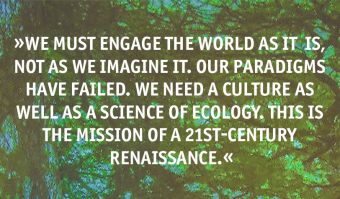
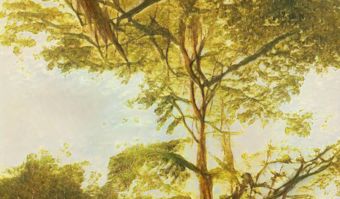
Let us return to spatial media. How should the multiverse evolve? Should it sever humanity from nature, or can it bind society to ecology? Should it enable monopoly, even tyranny, or provide opportunities for all? Markets will determine the multiverse’s form but so will designers. Rather than inventing for its own sake, the multiverse’s engineers need to judge outcomes. Good intentions alone are a recipe for disaster. In the 1990s, I deployed social media into television networks. My goal was to create media for a democratic society. Massive channels, controlled by a few, should be fragmented into capillaries run by individuals. Social media would—I thought—encourage critical thought, dialogue and solidarity.
Here’s another lesson from the Quattrocento. Its polymaths did not separate thinking, making and doing. Nor did they separate ethics, aesthetics and technics. Today holism is deeply unpopular, but I think it is vital for innovators to adopt it. And I argue that holism is vital for producing commercially viable forms of spatial media. The multiverse is not an end in itself: it is the foundation for future generations to innovate. My work in developing standards for ethical design of AI and brain-computer interface has convinced me that media will converge with architecture, urbanism and biology. The next-generation Internet will transcend our current conceptions. Did Alberti imagine streaming media when he wrote On Painting? Imagine the value unleashed by 21st-century infrastructure which supports decades, even centuries, of progress.
Contemporary crises stem from narrow expertise coupled to wishful thinking. Like Quattrocento polymaths, future designers should hold clear aesthetic and ethical values, and they should embed them in their inventions. Alberti, Brunelleschi and da Vinci were humanists, and here they are obsolete. Man is not the measure of things: We need to embrace the biosphere. Like von Humboldt, we should be ecologists who position humanity in nature. A culture of ecology reflects this understanding. It understands the depth of our crisis—the survival of humanity—while driving economic growth.
In a world where inventions are quickly commoditised, culture generates profit. Renaissance polymaths were supported by mecenati, patrons motivated by fame coupled to humanism and social progress. Investors in the New European Renaissance require similar motivations. As Alexander von Humboldt observed, everything is connected. Europe must progress, but European progress should serve, not overrun, the planet.

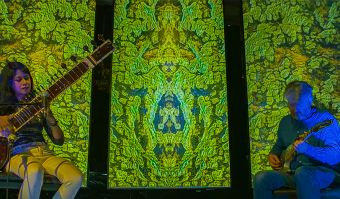
The New European Renaissance could mesh creative industry, science and engineering with an ethos of global awareness. It would preserve the cohesion of European institutions, and it would support the relevance of European industry—and the European project—in a world of superpowers. Let us invest in a 21st-century Renaissance that starts in Europe but benefits every global citizen. Europe’s institutions, the heirs of the mecenati, can generate vast new wealth, and they can also ensure the benefits of prosperity for future generations. What illuminates this path to a bright future? Humanity, technology and ecology coupled to creative imagination.
Photo left: GROUPTHINK: The Internet of Neurons
Neuroscientist Shama Rahman and computer scientist Mick Grierson collaborated with Ali Hossaini, an AI and a cohort of artist-engineers to create GROUPTHINK. Performed at National Gallery X in London and broadcast via Ars Electronica Festival 2021. (c) 2021 Ali Hossaini
More info on the artworks
Epiphany: The Cycle of Life.
https://pantar.com/epiphany/
GROUPTHINK: The Internet of Neurons
https://www.nationalgallery.org.uk/national-gallery-x/groupthink
Sources
All portrayed pictures and paintings in this contribution are (c) Ali Hossaini, 2021.
Dr. Ali Hossaini
Fellow at King’s College London and The National Gallery X, London
Ali Hossaini works at the cutting edge of art, technology and science. Acclaimed by the New York Times, which calls him “a biochemist turned philosopher turned television producer turned visual poet,“ he is noted for cross-disciplinary work that addresses thorny problems. He is a Visiting Senior Research Fellow in the Department of Engineering at King’s College London. In this capacity, he has developed use cases for 5G with Ericsson, studied unequal healthcare outcomes at the Institute of Psychiatry, Psychology and Neuroscience, and assessed the threat from AI with security think tank RUSI. He serves on IEEE committees developing standards for safe AI and brain-computer interface, and he is active as a visual artist, writer and director. In 2019 he co-founded National Gallery X, a program that researches the future of art and audience, where he serves as co-director.
Picture: © Leslie Cummins
